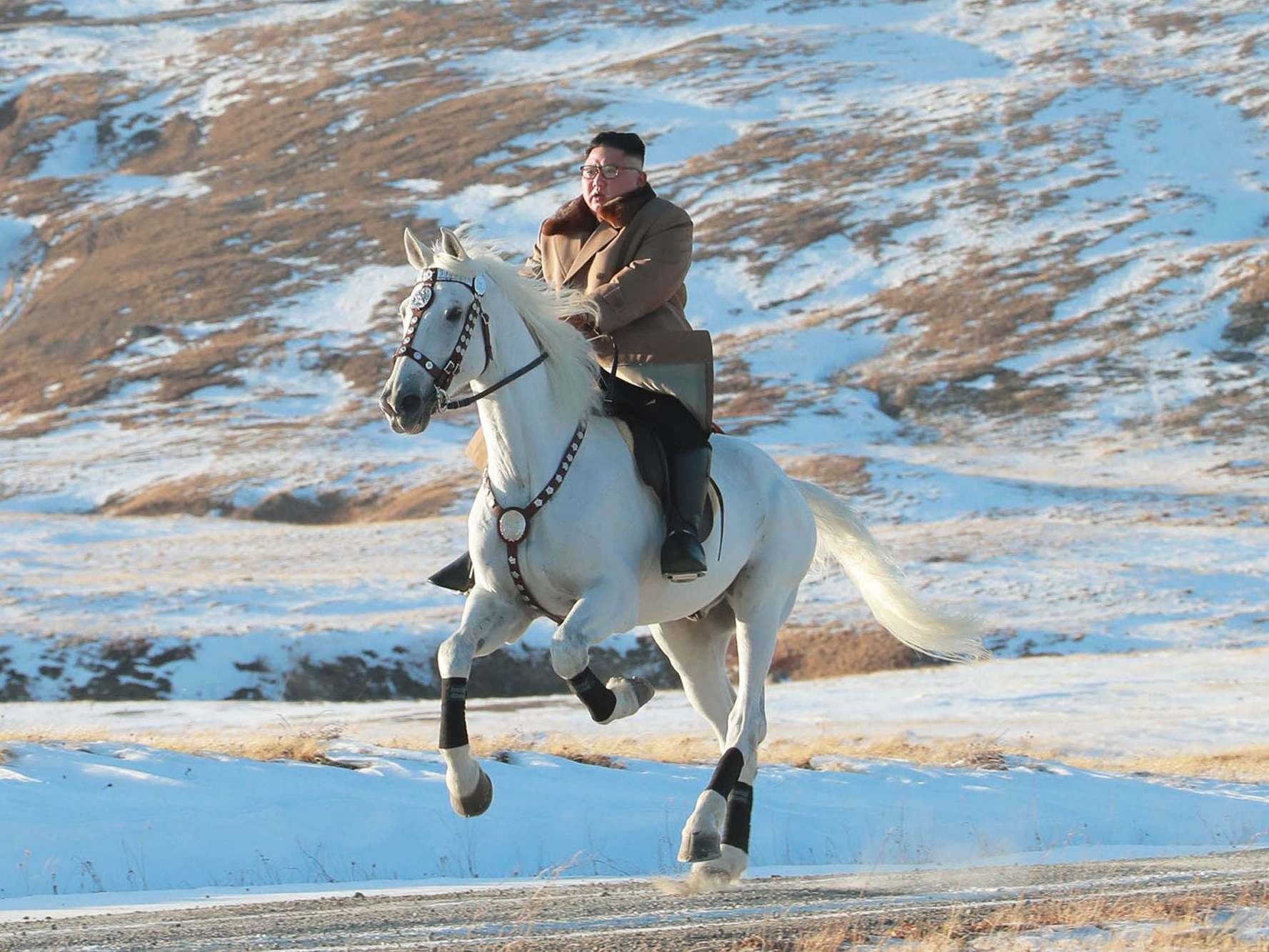Kim Jong-un rides white horse up sacred mountain
Trip up 2,750m peak follows similar 2017 visit, which was the precursor to an important policy shift

He is a world leader whose figure does not suggest an over-familiarity with vigorous exercise, but Kim Jong-un is used to building up the “myth” around his family name.
He has just scaled North Korea’s highest peak on the back of a white stallion, according to state media, using the time to recollect “with deep emotion the road of arduous struggle he covered for the great cause of building the most powerful country”.
Official pictures show the dictator atop the immaculate equine after apparently riding it up the 2,750 metres of Mt Paektu. Both the mountain, and the images of white horses, are deeply associated with the Kim dynasty and its presentation to the country’s people.
North Korean documents claim Mr Kim’s grandfather and national founder Kim Il-sung had an anti-Japan guerrilla base on Paektu’s slopes during Japan’s colonial rule of the Korean Peninsula from 1910 to 1945. The official biography of the current leader’s father, Kim Jong-il, says he was born on Paektu when a double rainbow filled the skies. State media have occasionally shown Mr Kim, his sister and his father riding white horses. The symbolism goes back to Kim Il-sung, who according to the North’s official narrative rode a white horse while fighting Japanese colonial rulers.
The latest trip to the peak may precede a major announcement, analysts have suggested, as it has become a favoured place for Mr Kim to visit before revealing policy shifts.
In 2017, he went there days after North Korea launched its largest intercontinental ballistic missile, and weeks before before first hinting at a diplomatic thaw with South Korea.
Last year, Kim took South Korean president Moon Jae-in to the top of the mountain as part of a historic summit.
On Wednesday, the Rodong Sinmun state newspaper reported that Mr Kim “rode a white horse to the top of Mt Paektu in the first snow”.
It added: “All the officials who accompanied him to the top of the mountain felt overflowing emotion and joy, and [were] convinced that there will be a great operation to strike the world with wonder again and advance the Korean revolution a step forward.
“His march on horseback in Mt Paektu is a great event of weighty importance in the history of the Korean revolution.”
The outing came after talks with Donald Trump’s administration, aimed at lifting sanctions in exchange for Pyongyang abandoning its nuclear ambitions, broke down. North Korea walked away from high-level negotiations in Sweden earlier this month with top envoy Kim Myong-gil saying the talks had “not fulfilled our expectation”.
State media outlet KCNA said Mr Kim also visited nearby construction sites in Samjiyon County and complained about US-led UN sanctions imposed on his country because of its nuclear and missile programmes.
“The situation of the country is difficult owing to the ceaseless sanctions and pressure by the hostile forces and there are many hardships and trials facing us,” Kim was quoted as saying. “But our people grew stronger through the trials and found their own way of development and learned how to always win in the face of trials.”
Mr Kim said of American sanctions: “Whenever the enemies try to strangle us with the chain of pressure, we should pave the way with our own efforts to continue to live well under the banner of the great spirit of self-reliance so that the enemies feel a pain in their stomach and head.”
Pyongyang has faced 11 rounds of sanctions since 2006, with the diplomatic pressure intensifying in 2016 after Mr Kim began conducting a series of high-profile nuclear and missile tests and Mr Trump responded by claiming he would “bring fire and fury” down on the country if they went further. The latest sanctions include a full ban on key exports such as coal, textiles and seafood and a significant curtailing of oil imports.
During his second summit with Mr Trump in Vietnam in February, Mr Kim demanded the United States lift the newer sanctions in return for Pyongyang dismantling the country’s main nuclear complex, a limited step. Mr Trump rejected that, and the summit collapsed without reaching any deal. Although there was impromptu meeting at the Korean border in late June where the pair agreed to resume talks before the latest derailment.
There have been a number of recent short-range missile tests by North Korea, but Mr Trump has sought to play down their significance as he continues to strive for a diplomatic deal that he believes will cement his legacy.
Reuters contributed to this report
Join our commenting forum
Join thought-provoking conversations, follow other Independent readers and see their replies
Comments